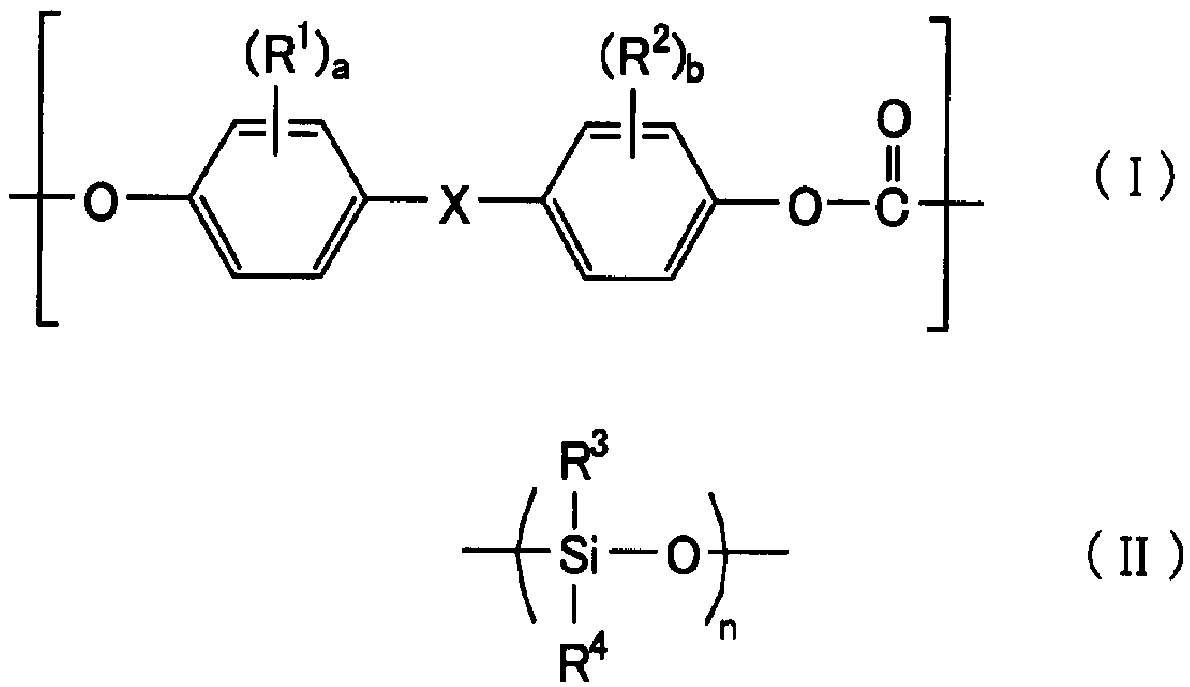Molded body for outdoor installation
A molded body, polycarbonate technology, applied in the field of molded bodies for outdoor installations, can solve the problems of reduced weather resistance, yellowing, and reduced impact resistance of polycarbonate resin, and achieve the effect of excellent impact resistance
- Summary
- Abstract
- Description
- Claims
- Application Information
AI Technical Summary
Problems solved by technology
Method used
Image
Examples
preparation example 1
[0167]
[0168] 2000 ppm of sodium dithionite was added to a 5.6 mass % sodium hydroxide aqueous solution with respect to the bisphenol A (BPA) to be dissolved later, and bisphenol A was dissolved therein so that the bisphenol A concentration became 13.5 mass % to prepare bisphenol A (BPA). Phenol A in aqueous sodium hydroxide solution.
[0169] The aqueous sodium hydroxide solution of bisphenol A, dichloromethane, and phosgene were continuously fed at an amount of 40 L (hereinafter, L is an abbreviated form of liter.) / hr, a flow rate of 15 L / hr, and a flow rate of 4.0 kg / hr, respectively. It is passed into a tubular reactor with an inner diameter of 6 mm and a tube length of 30 m.
[0170] The tubular reactor has a jacket part, and cooling water is passed into the jacket to keep the temperature of the reaction solution below 40°C.
[0171]The reaction solution flowing out from the tubular reactor is continuously introduced into a baffled tank reactor with an internal volum...
manufacture example 1
[0175]
[0176] 15 L of the polycarbonate oligomer solution, 9.0 L of dichloromethane, and dimethylsiloxane were put into a 50 L tank reactor equipped with a baffle plate, a paddle-type stirring blade, and a cooling jacket. 384 g of ortho-allylphenol terminal-modified polydimethylsiloxane (PDMS) and 8.8 mL of triethylamine having an average repeating number n of 90 of the repeating unit, were added thereto with stirring 1389 g of 6.4% by mass sodium hydroxide aqueous solution , for 10 min to react polycarbonate oligomers with allylphenol end-modified PDMS.
[0177] A dichloromethane solution of p-tert-butylphenol (PTBP) (132 g of PTBP dissolved in 2.0 L of dichloromethane), an aqueous sodium hydroxide solution of bisphenol A (sodium hydroxide 577 g and 2.0 g of sodium dithionite were dissolved in 8.4 L of water in an aqueous solution obtained by dissolving 1012 g of bisphenol A), and a polymerization reaction was performed for 50 minutes.
manufacture example 2
[0183]
[0184] In Production Example 1, using ortho-allylphenol terminal-modified PDMS in which the average repeating number n of dimethylsiloxane repeating units was 150, and changing the usage amount to 224 g, the same method as in Production Example 1 was used. PC-PDMS copolymer 2 was produced similarly.
[0185] The obtained PC-PDMS copolymer 2 had a PDMS block content determined by NMR of 3.5% by mass, a viscosity value measured in accordance with ISO1628-4 (1999) of 48.2, and a viscosity average molecular weight Mv of 18,000.
PUM
| Property | Measurement | Unit |
|---|---|---|
| electrical conductivity | aaaaa | aaaaa |
| viscosity average molecular weight | aaaaa | aaaaa |
| viscosity average molecular weight | aaaaa | aaaaa |
Abstract
Description
Claims
Application Information
 Login to View More
Login to View More - Generate Ideas
- Intellectual Property
- Life Sciences
- Materials
- Tech Scout
- Unparalleled Data Quality
- Higher Quality Content
- 60% Fewer Hallucinations
Browse by: Latest US Patents, China's latest patents, Technical Efficacy Thesaurus, Application Domain, Technology Topic, Popular Technical Reports.
© 2025 PatSnap. All rights reserved.Legal|Privacy policy|Modern Slavery Act Transparency Statement|Sitemap|About US| Contact US: help@patsnap.com



